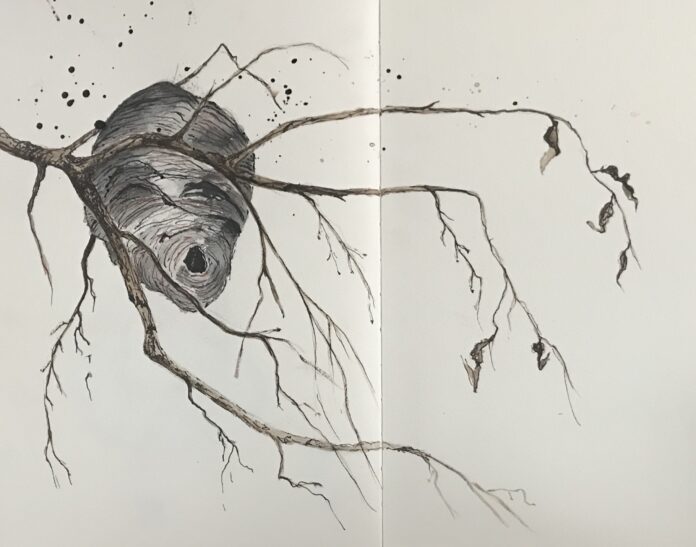BY LESLIE REGO

In the past two months I have found three hornets’ nests right after they fell to the ground. One was the entire circumference of the hive, with the entrance for the hornets intact, although the cells inside had been destroyed. Another was half a nest, but the cells were still visible, and the third had only some of the outer sections surviving.
Every year the hornet’s home is rebuilt. The queen initiates the building of the hive by chewing wood to make a papery pulp. She manufactures around 50 hexagonal cells. Once the cells are finished, the queen lays an egg into each one. Subsequent generations of hornets add to the cells, layer by layer, thus expanding the structure. An entry is left in the bottom so the workers can enter and leave.
The nest I discovered with the ingress intact has six layers of woven paper. Every layer has striations ranging from dove-grey to deeper values of grey. The striations curve around the circumference and each one represents the effort of a single hornet.
The wafer-thin sections I recovered with the cells attached show how straight the hornet is able to construct the hexagonal spaces. This is an incredible feat considering all of the work is done deep within the edifice and is therefore accomplished in the dark.
The bits and pieces I unearthed are significantly different in their use of color. The paper has pink striations mixed in with the greys. The greys are the lightest I have ever seen, some verging on white. Each change in color represents a different type of wood. I have never encountered a hive with this muted rose hue and I wonder what wood pulp was chewed.
Several weeks ago I found a hive hanging high in a cottonwood tree. It has not fallen yet, although there have been several storms. But when it does tumble and the delicate hornet-made paper gets wet, the sculpted form will rapidly disintegrate. I want to be quick to retrieve the woven gem.
The story of a hornet’s abode is told through every line, wrinkle, and crack. The weathered fragments become part of its memory. The hornet’s dwelling is fragile and yet speaks of great strength.
Leslie Rego is an Idaho Press Club award-winning columnist, artist and Blaine County resident. To view more of Rego’s art, visit www.leslierego.com.



